Digital and the Wildlife Photographer -
Part II
by B. Moose Peterson
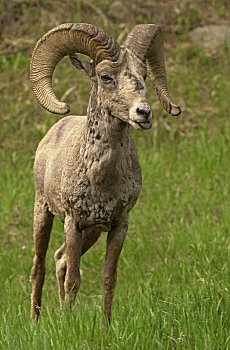 |
|
Rocky Mountain Bighorn Sheep - Nikon D1, Nikon 300mm f2.8 AFS II on Lexar digital film |
Building from the ground up. This is how I do nearly everything, creating a foundation from which to grow and build upon. This method has always served me well because if something ever goes awry, then I can always fall back on the already proven. This basic philosophy for learning is exactly how I approach digital photography. Starting with the "pocket" digital camera, I created a foundation so when I jumped into the D1/x/h and digital medium fulltime, if anything does go wrong (and it does), I can always fall back and regroup. I've been shooting with the D1 for 18 months and the workflow I developed first for shooting with the pocket camera couldn't have turned out better!
The goal of any piece of equipment is to permit photographers to capture what they see on "film" so they can communicate. I personally find the D1/x/h the ultimate tool, permitting me to do exactly that! I receive an incredible amount of e-mails asking just how I can work strictly digital, foregoing the traditional conventional film format especially in the business of selling images. Well, I'm going to lay it all out for you here right now!
Before Going Out the Door
Shooting digital with the D1 starts before you ever go out the door. There are a number of things I check before I actually start shooting. I did this same thing with conventional, but the laundry list was a lot shorter. The first thing I do is to make sure the camera is set to the settings I have standardized on. These standard settings come from testing and shooting the D1 for some time, they didn't just happen (I wish). The settings I have my D1 set to are: Metering-matrix, Autofocus-dynamic & continuous, Film advance-continuous, File quality-FINE mode, White Balance-cloudy -3, Flash Sync-slow, Custom functions 1-2, 2-2, 6-1, 11-AS, 14-8, 15-6, 16-10, 19-1, 25-CH, 26-21, 27-2, 29-1 in set A plus a charged EN-4 battery.
Why have I selected these settings? Here's why. The metering on the D1 while being excellent is not perfect like the F5. The matrix mode performs great except in certain situations such as a bright subject in front of a dark background. You might want to dial in -1/3 or more in this scenario. With the D1 being digital though, you can instantly check the LCD to see if you need any compensation and if so, if you've dialed in enough. Using custom function #27 on the D1 actually helps you quickly understand if this is the case.
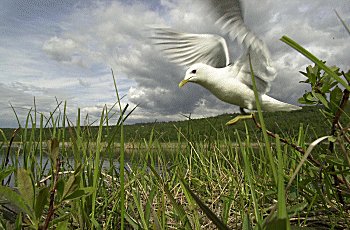 |
|
Mew Gull - Nikon D1, Nikon 14mm f2.8 on Lexar digital film |
I depend on autofocus, which is something I thought would never come to be. Nikon's AF system allows me the luxury of concentrating on the subject rather than this technical aspect of photography. The D1 with its Dynamic Focus mode makes photographing action a snap, especially when in continuous focus mode. The film advance (funny term considering there is no film advancing) is set to continuous so I can capture action anytime, any place. The next selection is going to take more than a mere sentence to explain.
The D1 has many file quality settings, ranging from a file capture of 7.8MB to 320K. Why have I chosen the FINE mode, which captures a 1.3MB file? Contrary to what most probably have read and heard, you don't need big files to capture big quality! Yes, mathematically and logically it would seem the more info you have in your file, the better the results. But the reality of digital with the D1, while this logic is accurate it's not needed. The problem is that you won't really realize the quality of a D1 file looking at any image on the web.
How can I give you confidence and comfort that a 1.3MB file works? I can tell you that I've had a dozen magazine covers and over 400 original digital capture images in print in the past year. I can tell you about a software maker who made a 7'x4' footprint for PhotoKina that the public couldn't tell came from digital. I could invite you all to my home to see my 30"x40" digital prints, but I don't think my wife would be happy with all the guests. I could tell you this is the most common file size for newspapers, but all of this still flies in the face of all the "webwisdom" so often quoted. Image quality in my honest opinion comes not from the file size but the fundamentals in which all photography is based, excellent optics, great lighting and sharp focus (for sharp images, refer to the
March issue, Proper Technique for Wide Angle & Telephoto
Lenses).
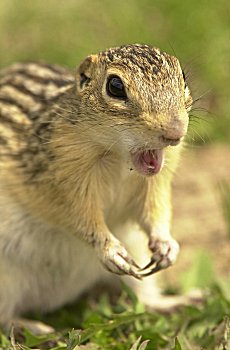 |
|
Thirteen-lined Squirrel - Nikon D1, Nikon 600mm f4 AFS w/TC-14e
teleconverter on Lexar digital film |
There is a real operational benefit to this file size as well. The D1 performs its fastest, as in capturing and writing files with this file size. Using the Lexar 256 12x cards, I can capture and write a 21 frame burst in just 24 seconds (the fastest the D1 goes). Also, I can store a big quantity with the FINE mode, capturing over 200 captures in just one card.
White Balance is based on the obvious, color balance. With conventional film having a color balance of 5500k and that being the baseline for digital, I use the closest D1 setting, Cloudy -3. This works for me 95% of the time and if in doubt, a quickly look at the LCD, which confirms what is right or wrong. I have the Slow-sync mode as standard because
I often use my flash to balance the ambient light at shutter speeds of 1/60 or slower.
Finally, the custom functions permit me to customize the D1 to fit my shooting and filing parameters. And with all of this and a CompactFlash card inserted and formatted (I do that after every download) it's out the door and
onto the important stuff - shooting.
Shooting with the D1
The most obvious thing you need next to getting out shooting is a lens. But with the D1 you might have to rethink your lens selection. Why's this? The D1 like all digital cameras "sees" only the center of the optical path. This translates into a focal length increase of 50% or in other words, a 600f4 lens on a D1 is equal to a 900f4 on conventional bodies! For the wildlife photographer, this is a killer advantage to digital. For example you can use the 80-400VR lens on the D1 and have a 120-600 handholdable lens!
There is no magnification going on here, it's simply the D1 doesn't see all the information the lens is projecting because of the physical size of the CCD. This means that while you get more focal length for your D1 buck, you also retain the speed of the lens! A 400f2.8 on the D1 is a 600f2.8, that's a lot of fast lens! With lenses directly dictating your shooting style, this 50% increase can affect your lens selection. Let me give you some ideas how.
When I built my new office in the summer of 2000, I designed it so I can literally sit at my desk like I am now writing this piece and photograph out the windows at the birds in my feeders. You might think that such a pursuit requires a 600f4 with 1.4x teleconverter. Actually shooting with the D1, I have found the best combo is the new 300f2.8 AFS II with TC-14e. This combo on the D1 gives me a 630f4 lens that focuses down to 7.5 feet (it's equal to 420f4 on a conventional body)!
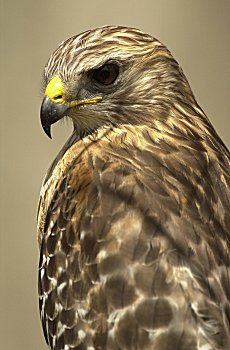 |
|
Red-shouldered Hawk - Nikon D1, Nikon 600f4 AFS w/TC-14e teleconverter on Lexar digital film |
There is a flip side to this though, ultra wides. The same apparent focal length benefit for the telephoto is a real drawback for the scenic, ultra wide shooter. I shoot with the Nikon 14f2.8, love its wide breadth but on the D1 it's equivalent to a 21f2.8. Ouch! So like I said, you probably need to rethink your lens selection for shooting with the D1. (Note: If you have a 500mm lens and you're thinking of buying a 600mm because you want longer reach, you can buy the D1 for less than the new lens and have a longer lens to boot!)
With lens attached and the D1 turned on, it's time to make some images. The first thing I do, if I have the luxury of time, is take one test shot. I do this not only to make sure all systems are A-OK but also to double check exposure and white balance. With that accomplished, I just shoot, filling up my CF cards with as many great images as I can create.
There are a couple of general things I have found in shooting with the D1 that I'd like to pass along. The D1 doesn't slow down for rain or cold. I've used the D1 in just as adverse conditions as I would use the F5 and without any problems. The D1 uses batteries, no way around it. I generally make sure I have one battery for each 256/320 CF card. When I go out to shoot and I'm leaving the camera bag behind, I always have a battery or two in tow as per the ratio I just mentioned. Other than that, shooting with the D1 is tons of fun!
The Digital Editing, Filing System
With one or more CompactFlash cards filled with photographic treasures, what's next? It's back to the computer. Here you have many options, tons in fact and I really don't believe that there is any one platform or way that is perfect. Here's the solution I've come up with for my workflow and myself.
If I'm in the field, as in away from my office for longer than a day, the images go into my notebook. I use a Dell Inspiron 5000 with a 18GB hard drive, 650 processor running Win2k. If I'm in the office, then the images go straight into the network, my workstation being where the images reside. I'm running a Dell 420 Workstation with an 850 processor and multiple hard drives running Win2k. The workflow for getting the images off the CompactFlash and into a computer is the same no matter if it's the notebook or network.
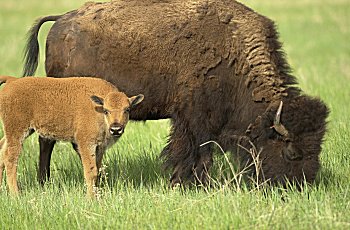 |
|
Bison - Nikon D1, Nikon 300mm f2.8AFS II
on Lexar digital film |
I couldn't find a software that I liked that did everything I wanted, so I had one made. My partner who is the genius in the partnership developed an incredible software called DigitalPro. This one software permits me to edit, file, view and make submissions from my digital files. When it comes to importing images from my CompactFlash cards, all I literally have to do is plug the CF card into a port, call up DigitalPro, click on one icon and all my images are instantly in the software as fast as they can load.
Once the images are imported, another couple of clicks and I can check for focus with the patented Digital Loupe, file and number. To put this into perspective, the time to get my conventional film processed, edited and filed, say just twenty rolls, would require a minimum of three days (I have to ship my film out for processing). In comparison with digital film using DigitalPro, the same 20 rolls of film take a maximum of 30 minutes to edit, file and number! Talk about a killer workflow because that incredible savings of time means I can go out and shoot more!
How are my digital files organized? This is a real common question. My images reside on two separate hard drives in my workstation. The previews generated by DigitalPro like other viewing softwares reside in the main hard drive that has all the operational software. The image files themselves reside on hard drives, which have no operational software residing on them. Each of these hard drives is 36Gb, so currently I have 72GB of image storage space. DigitalPro displays the "tree" for each of these drives. I have organized my files (and therefore my tree) the exact same way as my conventional files. Birds, mammals, insects, reptiles, locations, etc make up the main directories and then subdirectories organize the rest. I use the exact same numbering system for my digital files as with my conventional files except the first letter in the alphanumeric code for my original digital captured images begin with a "D".
These hard drives that store the images are continually backed up with a tape backup. This is done once a week or when I upload a whole lot of images from one shoot. I don't store any images on CD or other medium at this time. I do alternate the backup tapes so I'm never backing up to my last backup tape.
How did a longtime conventional shooter become so versed in digital in such a short time? How did I get so experienced as to be able to design a software for digital images? Workflow! The baseline knowledge I acquired by starting out with the Nikon Cooplix 900 is something I will always be thankful for. Yeah, you can start right off with a D1X, but you will be reinventing the wheel for a long time without that baseline (or rereading this series a few times and taking my suggestions). I receive hundreds of e-mails and one
recurring question is, "where do you find the time?" I'm here to tell you that digital is where I find the time!
|
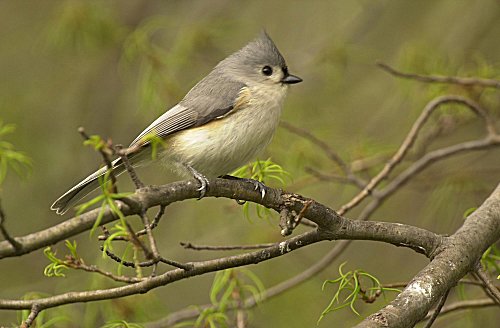
|
|
Tufted Titmouse - Nikon D1, Nikon 600mm f4 AFS
on Lexar digital film |
The Cost
"How can you recommend a medium that is so bloody expensive, have you no conscious?" I received that e-mail about a year ago and it illustrates the scare factor that capitalizing digital photography creates. This is a very valid point, not many folks have $5k to plunk down for a new camera body. And if they don't have a computer, software and other peripherals, man, the cost of digital photography is downright stifling! I can't make the sting go away and it won't help your workflow, but here are some of the numbers for digital.
CompactFlash cards aren't cheap! When you compare the cost of one flash card, it's about the same as 100 rolls of film. After you've exposed those 100 rolls of film, you have to pay for processing and then buy more film again. With the CompactFlash card, once you've made the initial purchase, there is no more cost associated with digital film. Once the CF card filled with images has been downloaded and the card formatted, it's ready to be filled up again. This effect for me personally last year was the reduction by $12k on my film and processing costs (remember I started to shoot digital fulltime in June!).
Not so obvious are the filing costs of conventional film compared to digital. Filing cabinets, slide pages and hanging rails add up, I know with 320k conventional filed images. The ten filing cabinets holding all of these images weigh in over 2 tons and take up a wall. In comparison, all of my digital images, about 30k worth, reside in a little white box under my desk and in case of a fire, can be grabbed and easily carried to safety.
And like I mentioned earlier, digital is a real easy way to increase your lens' focal length for little money. If you find a used D1, which are out there, you might spend $3500 for it. What long, fast telephoto can you buy for that price? If you factor in the cost of time, digital truly excels. I've already mentioned the editing, filing process, but think about the airport. Digital film, CompactFlash is not affected by security x-rays, no more hassle getting film hand checked (and what a space saver!).
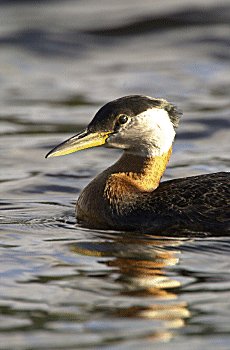 |
|
Red-necked Grebe - Nikon D1, Nikon 600mm f4 AFS, w/TC-20e teleconverter
on Lexar digital film |
Digital has brought so much fun and enjoyment to my photography; it's hard to express it all except through my photography! You've read part I and now part II and you're asking yourself, is there a part III? You bet, but that will be written by you! If you're just starting out in digital, you now have a blueprint for starting with pocket digital cameras and your computer. If you're a D1 shooter, you probably can better utilize this killer tool. And if you have just purchased a D1X or D1H, then you have a foundation from which to learn how to use these new digital tools. To take full advantage of the new technology, you must develop your baseline of knowledge and then your own workflow. If a computer neophyte such as myself can do it and have so much fun in the process, I know any photographer can do it!
In August, I'll be releasing my first self-published book, The D1 Generation. Co-authored with my partner David Cardinal, TDG covers operation of the D1, D1X, D1H as well as all of the computer stuff that goes on behind the scene, both in the camera and in the processing of the image. We will also be offering the first version of our software, DigitalPro. You can find out more about this at
www.nikondigital.org
 Subscribe to
Vivid Light
Subscribe to
Vivid Light
Photography by email
|
|
Developing a digital workflow
so you can improve your photography
I don't believe in "fixing" things in the computer
|